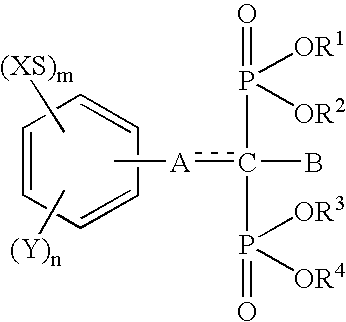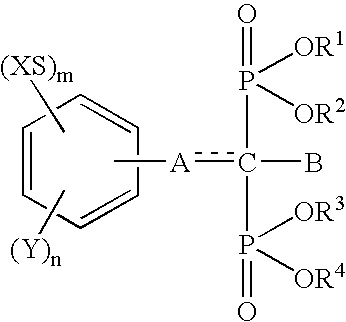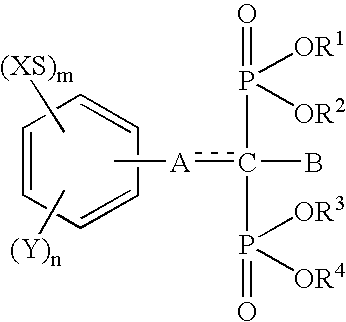Insertion stabilizers for implants
a technology for insertion stabilizers and implants, applied in the direction of prosthesis, drug compositions, group 5/15 element organic compounds, etc., can solve the problems of loosing, detachment finally, interim lowering of quality of life, and financial burden on patients
- Summary
- Abstract
- Description
- Claims
- Application Information
AI Technical Summary
Problems solved by technology
Method used
Image
Examples
example 2
Inhibition of Interleukin-1.alpha. (IL-1.alpha.) Production Within Granulation Tissue in the Rat Osteolysis Model
In an osteolysis model prepared in the same way as in Example 1, granulation tissue was collected either 4 weeks or 8 weeks after the model preparation. Compound 1 was administered in the same way as in Example 1. Isogen was added in the proportion of 1 ml to 100 mg of granulation tissue and, after cutting finely using scissors, homogenisation was performed. To this was added 0.2 ml of chloroform, after which the aqueous phase was recovered. To this aqueous phase, 0.5 ml of isopropanol was then added and, after leaving to stand at room temperature for 10 minutes, centrifuging was carried out. To the sediment, 1 ml of 75% ethanol was added and centrifuging performed, then the sediment obtained dried by vacuum centrifugation, after which 20 .mu.l of SDS was added to give an RNA sample. This sample was subjected to the RT-PCR method and IL-1.alpha. production measured. The s...
example 3
Inhibition of TNF.alpha. Production in Granulation Tissue in the Rat Osteolysis Model
In an osteolysis model prepared in the same way as in Example 1, granulation tissue was collected 4 weeks or 8 weeks after the model preparation. Compound 1 was administered in the same way as in Example 1. Isogen was added in the proportion of 1 ml to 100 mg of granulation tissue and, after cutting finely using scissors, homogenisation was performed. To this was added 0.2 ml of chloroform, after which the aqueous phase was recovered. To this aqueous phase, 0.5 ml of isopropanol was then added and, after leaving to stand at room temperature for 10 minutes, centrifuging was carried out. To the sediment, 1 ml of 75% ethanol was added and centrifuging performed, then the sediment obtained dried by vacuum centrifugation, after which 20 .mu.l of SDS was added to give an RNA sample. This sample was subjected to the RT-PCR method and TNF.alpha. production measured.
The sample subjected to the RT-PCR method ...
example 4
Inhibition of Osteolysis in the Rat Osteolysis Model
In an osteolysis model prepared in the same way as in Example 1, femurs were collected 4 weeks or 8 weeks after the model preparation. Compound 1 was administered in the same way as in Example 1.
The collected femurs were subjected to soft X-ray imaging in the state with the Kirschner wire inserted. It was found as a result that, 4 weeks and 8 weeks after the osteolysis model preparation, in the non-administration group the bone density at the Kirschner wire periphery was low and osteolysis had occurred, but in the case of the Compound 1 administration group osteolysis had been inhibited.
PUM
| Property | Measurement | Unit |
|---|---|---|
| diameter | aaaaa | aaaaa |
| interstitial | aaaaa | aaaaa |
| bone resorption | aaaaa | aaaaa |
Abstract
Description
Claims
Application Information
 Login to View More
Login to View More - R&D
- Intellectual Property
- Life Sciences
- Materials
- Tech Scout
- Unparalleled Data Quality
- Higher Quality Content
- 60% Fewer Hallucinations
Browse by: Latest US Patents, China's latest patents, Technical Efficacy Thesaurus, Application Domain, Technology Topic, Popular Technical Reports.
© 2025 PatSnap. All rights reserved.Legal|Privacy policy|Modern Slavery Act Transparency Statement|Sitemap|About US| Contact US: help@patsnap.com



